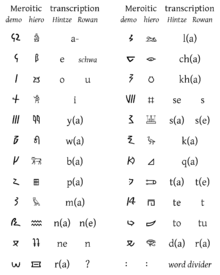Meroitic alphabet
| Meroitic |
|
|---|---|
 |
|
| Type |
Alphabet with inherent vowel /a/
|
| Languages | Meroitic and possibly Old Nubian |
|
Time period
|
300 BC to 600 AD |
|
Parent systems
|
Egyptian hieroglyphs
|
| ISO 15924 |
Mero, 100: Meroitic HieroglyphsMerc, 101: Meroitic Cursive |
|
|
The Meroitic script is an alphabetic script, used to write the Meroitic language of the Kingdom of Meroë in Sudan. It was developed in the Napatan Period (about 700–300 BCE), and first appears in the 2nd century BCE. For a time, it was also possibly used to write the Nubian language of the successor Nubian kingdoms. Its use was described by the Greek historian Diodorus Siculus (about 50 BCE).
Although the Meroitic alphabet continued to be used by the Nubian kingdoms that succeeded the Kingdom of Meroë, it was replaced by the Greek alphabet with the Christianization of Nubia, in the sixth century. The Nubian form of the Greek alphabet retained three Meroitic letters.
The script was deciphered in 1909 by Francis Llewellyn Griffith, a British Egyptologist, based on the Meroitic spellings of Egyptian names. However, the Meroitic language itself has yet to be translated. In late 2008, the first complete royal dedication was found, which may help confirm or refute some of the current hypotheses.
The longest inscription found is in the Museum of Fine Arts, Boston.
There were two graphic forms of the Meroitic alphabet: monumental hieroglyphs, and a cursive. The majority of texts are cursive. Unlike Egyptian writing, there was a simple one-to-one correspondence between the two forms of Meroitic, except that in the cursive form, consonants are joined in ligatures to a following vowel i.
The direction of cursive writing was from right to left, top to bottom, while the monumental form was written top to bottom in columns going right to left. Monumental letters were oriented to face the beginning of the text, a feature inherited from their hieroglyphic origin.
Being primarily alphabetic, the Meroitic script worked differently than Egyptian hieroglyphs. Some scholars, such as Harald Haarmann, believe that the vowel letters of Meroitic are evidence for an influence of the Greek alphabet in its development.
...
Wikipedia
